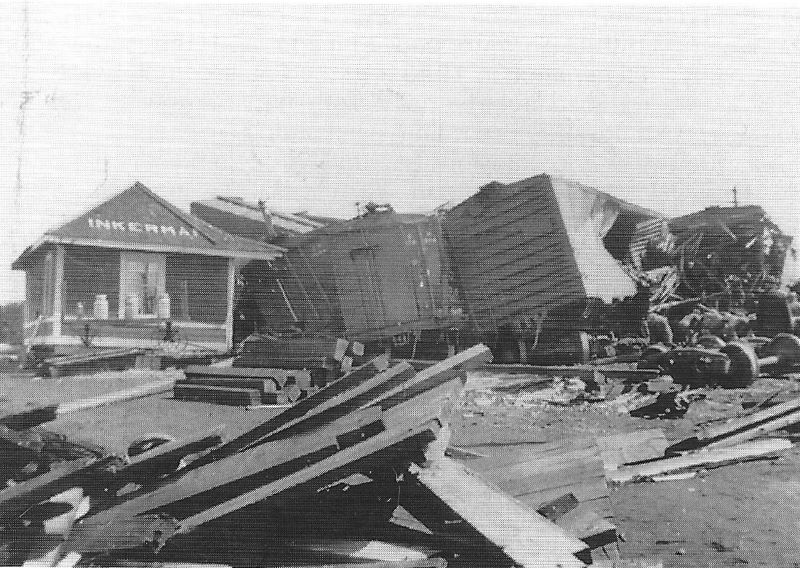On March 31, 1941, just eighty years ago, the small hamlet of Inkerman was the scene of a train accident that took the lives of three men and badly injured others. It took place at the station itself, and the extent of the destruction to the buildings and railway was quite incredible.
A Canadian Pacific passenger train, known as “The Perth Local”, was on its way from Montreal to Perth on the main Montreal to Toronto line, when it pulled into the Inkerman station around 6.30 in the evening. A few passengers and some empty milk cans were the cargo that day, the cans being returned to local farmers after their daily milk delivery to Montreal dairies. Just as it was coming to a stop at the station, a freight train heading in the opposite direction was passing through. Most of the freight train had passed the station when an axle on one of the rear freight cars broke, causing 24 of the 68 freight cars to pile up in an enormous crash of wood and iron.
Some of these cars hit the locomotive of the passenger train sideways on, pushing it over on its side in front of the station. The freight cars hit the station building, knocking it around three feet off its foundations, but leaving some empty milk cans still standing, as can be seen in the photograph. Many of the cars were reduced to matchwood, and the rails were torn up and twisted with the force of the impact. The wreckage was piled 30 feet high in places.

Fred Plato of Smiths Falls, and Wallace Plunkett from Mountain, the crew of The Perth Local, were killed. Witnesses said that Fred, the train’s engineer, tried to escape the cab, but didn’t make it. William Maxwell, a Canadian Pacific Section Foreman, jumped through a window in the station, but was badly scalded by the steam escaping the wreck, and although he was taken to the Ottawa Civic Hospital for treatment, he died the next evening.
Another CP employee in the station building, Edward Pennett, the Station Agent, who was sitting in his office when the crash occurred, also escaped through a window, suffering a badly gashed arm and burns to his face. A local farmer, George Suffel, along with his father and a farm hand witnessed the accident from their nearby land, and rushed to help. George helped Edward Pennett by putting a tourniquet on his arm and cutting away clothing to ease the pain from burns. Edward was treated in Winchester and recovered from the traumatic event.
George and his wife took the photographs that recorded the scene that day. He could have been much closer to the accident than he was, as he usually waited at the station to retrieve his milk cans on their return from Montreal. But he hadn’t shipped any milk that day, and so was not waiting on the station platform when the accident occurred.
There were some amazing close calls for others who were there at the time. Asa Hanes was a mailman from Inkerman who was waiting to get mail bags off the passenger train. He was bending over to pick up some bags when the force of the collision between the trains knocked him over. As he lay there, with wreckage flying around him, a military truck that had been on a flatbed of the freight train sailed right over his head. Asa walked away without injury.
Danny McDonald, a transient from Montreal, had hidden himself on the tender of the passenger train when it stopped at Chesterville, hoping to hitch an unpaid ride to Smiths Falls, where he was hoping to find work. Even though he survived the accident with heavy bruising to his legs and needed medical attention, he survived the accident, only to be sentenced to ten days in jail for vagrancy.
None of the 24 passengers on the train were injured, but other crew members received cuts and bruises, broken ribs and burns. A grain store shed around 90 feet from the station was also demolished by a derailed freight car, sending twelve tons of grain showering the scene of the accident. The track was ripped up for 300 feet and trains had to be diverted for some days before the rails could be relaid.
The total number of deaths was not complete. The day after the accident, A. J. Logsdail, Dean of the Kemptville Agricultural School, and his wife drove to Inkerman to view the scene. As they walked from their car to the site, Mrs. Logsdail collapsed with a heart attack and died.
The station building was later removed and became a residence in Mountain.

